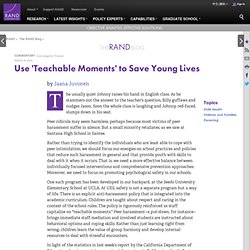

How Can We Tell Which Teen Will Kill? We Can't. Almost two years ago, after the Columbine shootings, I wrote an op-ed for this newspaper titled "Don't Blame the Parents. " I explained that parents often are wrongly blamed when something goes seriously amiss in a child's life. When a kid brings a gun to school and fires it, and people die, the grieving parents of the shooter are subjected to intense scrutiny. What did they do wrong? The belief that the parents of the shooter must have done something wrong serves as reassurance for other parents.
"I'm raising my kid right," they tell themselves. Unfortunately, there is a limit to what good parenting can do. Most school shooters are kids who were picked on or rejected by their peers. Though many school shooters tell others about their plans, I haven't heard of any who warned their parents. How can we tell who will and who won't?
I don't mean to suggest, however, that there is nothing parents can do. But some kids don't give clues. Ishmael Beah - "A Long Way Gone: Memoirs of a Boy Soldier" The Biology. Are the kids who are the butt of everyone's jokes the ones who are most likely to be violent? How could name-calling and rumor-mongering inspire murder? How many more killers are seething among the ranks of the unpopular? These are the inevitable questions after the allegations that accused Santana High School shooter Charles Andrew Williams was routinely teased and taunted by his peers. Some adults--certainly those who themselves were less than kind as teenagers--insist that bullying is just typical adolescent behavior. Psychologists who have studied the problem cite the quest for status, a culture that accepts domineering behavior as evidence of masculinity, an inability to regulate emotion, the thrill of conflict.
But people who study the brain will tell you that there is a biological reason that cruelty can lead to tragedy: Exposure to social abuse can re-engineer the brain. Take, for example, a study published in 1998 by researchers at the University of Massachusetts Medical Center. Use 'Teachable Moments' to Save Young Lives. The usually quiet Johnny raises his hand in English class.

As he stammers out the answer to the teacher's question, Billy guffaws and nudges Jason. Soon the whole class is laughing and Johnny, red-faced, slumps down in his seat. Peer ridicule may seem harmless, perhaps because most victims of peer harassment suffer in silence. But a small minority retaliates, as we saw at Santana High School in Santee. Rather than trying to identify the individuals who are least able to cope with peer intimidation, we should focus our energies on school practices and policies that reduce such harassment in general and that provide youth with skills to deal with it when it occurs. One such program has been developed in our backyard, at the Seeds University Elementary School at UCLA.
Home Page - Youth Violence - Violence Preveniton - Injury. Lord of the Flies. Lists of Nobel Prizes and Laureates Lord of the Flies Play the Lord of the Flies Game.

The Stanford Prison Experiment: A Simulation Study of the Psychology of Imprisonment. History - British History in depth: Evacuees in World War Two - the True Story. Do Juvenile Killers Deserve Life Behind Bars? Hide captionEvan Miller (in the white shirt) was sentenced to life in prison for a crime he committed when he was 14. Courtesy of Equal Justice Initiative Evan Miller (in the white shirt) was sentenced to life in prison for a crime he committed when he was 14. The U.S. Supreme Court hears arguments Tuesday in two homicide cases testing whether it is unconstitutionally cruel and unusual punishment to sentence a 14-year-old to life in prison without the possibility of parole.
There are currently 79 of these juvenile killers who will die in prison. In cases dealing with punishment for juveniles, context is everything. Two years ago, the court used the same rationale when it struck down the penalty of life without parole for nonhomicide crimes committed by juveniles. A case from Arkansas involves a teenager who was not the triggerman.
Miller and a 16-year-old friend went next-door to the home of a neighbor who was dealing drugs to Miller's mother. "Judges can't consider it. Golden Balls Game Theory.